sensor BMW 535I XDRIVE 2011 F10 User Guide
[x] Cancel search | Manufacturer: BMW, Model Year: 2011, Model line: 535I XDRIVE, Model: BMW 535I XDRIVE 2011 F10Pages: 304, PDF Size: 10.18 MB
Page 109 of 304
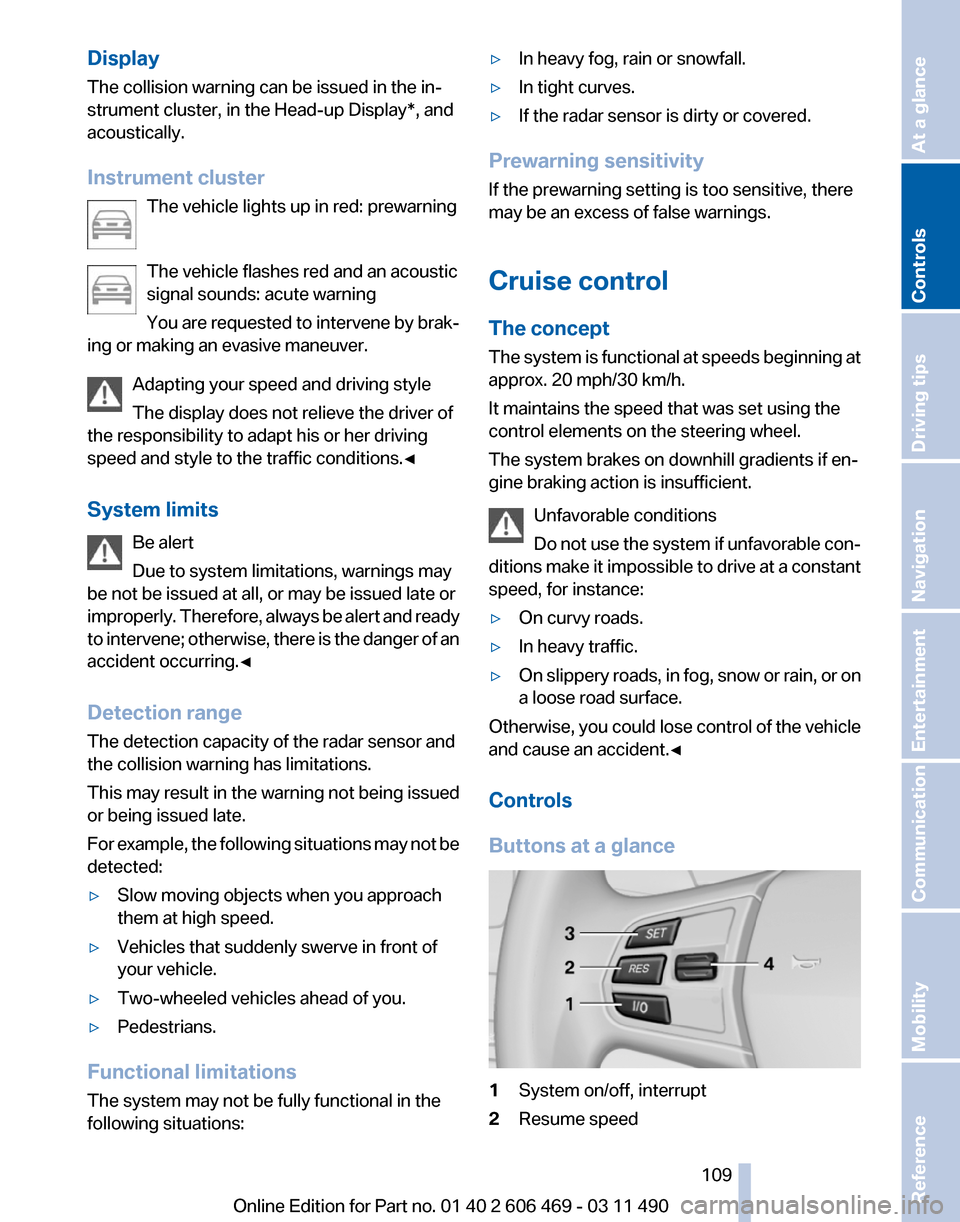
Display
The collision warning can be issued in the in‚Äê
strument cluster, in the Head-up Display*, and
acoustically.
Instrument cluster
The vehicle lights up in red: prewarning
The vehicle flashes red and an acoustic
signal sounds: acute warning
You
are requested to intervene by brak‚Äê
ing or making an evasive maneuver.
Adapting your speed and driving style
The display does not relieve the driver of
the responsibility to adapt his or her driving
speed and style to the traffic conditions.‚óÄ
System limits
Be alert
Due to system limitations, warnings may
be not be issued at all, or may be issued late or
improperly. Therefore, always be alert and ready
to intervene; otherwise, there is the danger of an
accident occurring.‚óÄ
Detection range
The detection capacity of the radar sensor and
the collision warning has limitations.
This may result in the warning not being issued
or being issued late.
For example, the following situations may not be
detected:
‚ñ∑ Slow moving objects when you approach
them at high speed.
‚ñ∑ Vehicles that suddenly swerve in front of
your vehicle.
‚ñ∑ Two-wheeled vehicles ahead of you.
‚ñ∑ Pedestrians.
Functional limitations
The system may not be fully functional in the
following situations: ‚ñ∑
In heavy fog, rain or snowfall.
‚ñ∑ In tight curves.
‚ñ∑ If the radar sensor is dirty or covered.
Prewarning sensitivity
If the prewarning setting is too sensitive, there
may be an excess of false warnings.
Cruise control
The concept
The
system is functional at speeds beginning at
approx. 20 mph/30 km/h.
It maintains the speed that was set using the
control elements on the steering wheel.
The system brakes on downhill gradients if en‚Äê
gine braking action is insufficient.
Unfavorable conditions
Do not use the system if unfavorable con‚Äê
ditions make it impossible to drive at a constant
speed, for instance:
‚ñ∑ On curvy roads.
‚ñ∑ In heavy traffic.
‚ñ∑ On slippery roads, in fog, snow or rain, or on
a loose road surface.
Otherwise, you could lose control of the vehicle
and cause an accident.‚óÄ
Controls
Buttons at a glance 1
System on/off, interrupt
2 Resume speed Seite 109
109Online Edition for Part no. 01 40 2 606 469 - 03 11 490
Reference Mobility Communication Entertainment Navigation Driving tips
Controls At a glance
Page 111 of 304
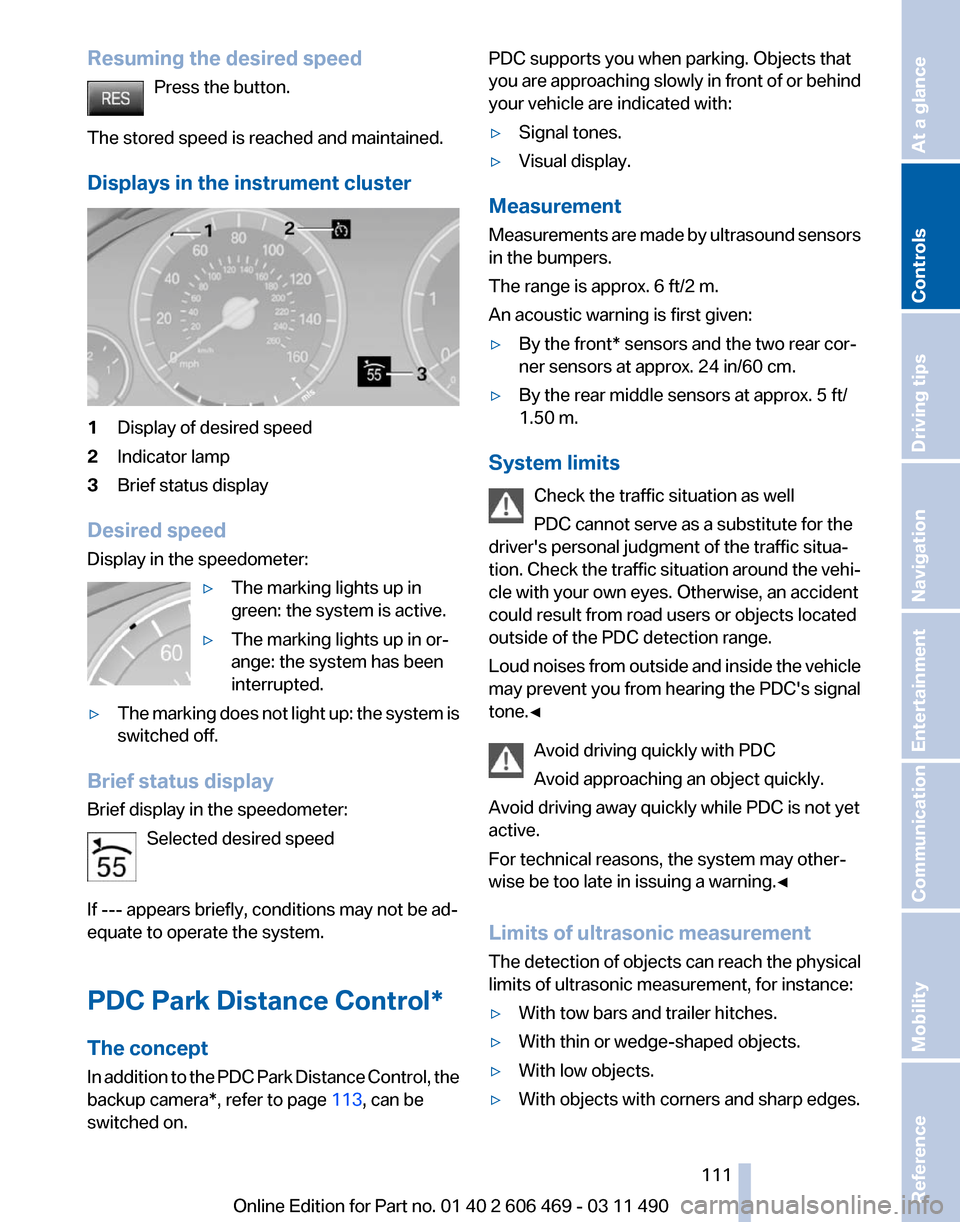
Resuming the desired speed
Press the button.
The stored speed is reached and maintained.
Displays in the instrument cluster 1
Display of desired speed
2 Indicator lamp
3 Brief status display
Desired speed
Display in the speedometer: ‚ñ∑The marking lights up in
green: the system is active.
‚ñ∑ The marking lights up in or‚Äê
ange: the system has been
interrupted.
‚ñ∑ The marking does not light up: the system is
switched off.
Brief status display
Brief display in the speedometer: Selected desired speed
If --- appears briefly, conditions may not be ad‚Äê
equate to operate the system.
PDC Park Distance Control*
The concept
In
addition to the PDC Park Distance Control, the
backup camera*, refer to page 113, can be
switched on. PDC supports you when parking. Objects that
you
are approaching slowly in front of or behind
your vehicle are indicated with:
‚ñ∑ Signal tones.
‚ñ∑ Visual display.
Measurement
Measurements
are made by ultrasound sensors
in the bumpers.
The range is approx. 6 ft/2 m.
An acoustic warning is first given:
‚ñ∑ By the front* sensors and the two rear cor‚Äê
ner sensors at approx. 24 in/60 cm.
‚ñ∑ By the rear middle sensors at approx. 5 ft/
1.50 m.
System limits Check the traffic situation as well
PDC cannot serve as a substitute for the
driver's personal judgment of the traffic situa‚Äê
tion.
Check the traffic situation around the vehi‚Äê
cle with your own eyes. Otherwise, an accident
could result from road users or objects located
outside of the PDC detection range.
Loud noises from outside and inside the vehicle
may prevent you from hearing the PDC's signal
tone.‚óÄ
Avoid driving quickly with PDC
Avoid approaching an object quickly.
Avoid driving away quickly while PDC is not yet
active.
For technical reasons, the system may other‚Äê
wise be too late in issuing a warning.‚óÄ
Limits of ultrasonic measurement
The detection of objects can reach the physical
limits of ultrasonic measurement, for instance:
‚ñ∑ With tow bars and trailer hitches.
‚ñ∑ With thin or wedge-shaped objects.
‚ñ∑ With low objects.
‚ñ∑ With objects with corners and sharp edges. Seite 111
111Online Edition for Part no. 01 40 2 606 469 - 03 11 490
Reference Mobility Communication Entertainment Navigation Driving tips
Controls At a glance
Page 112 of 304
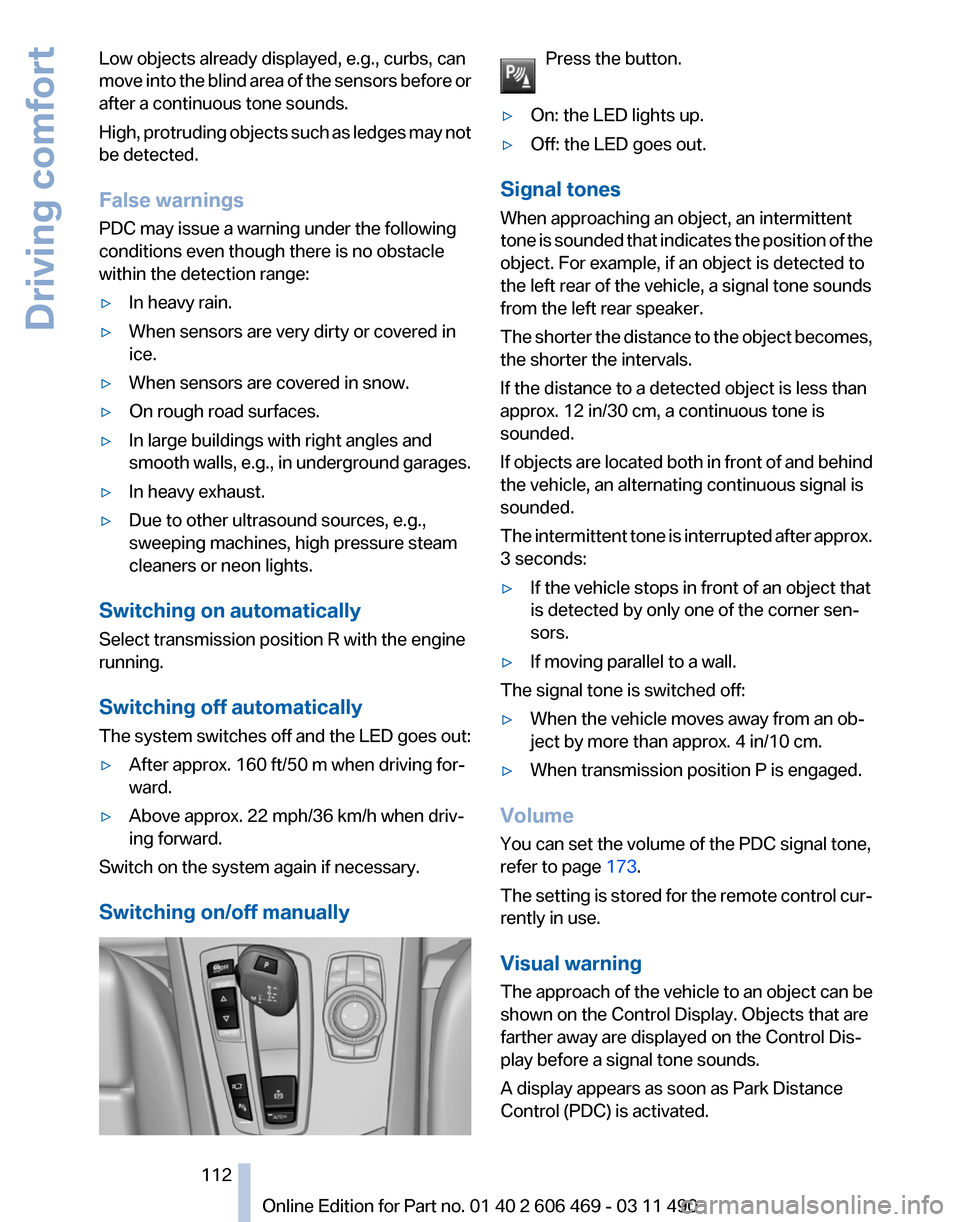
Low objects already displayed, e.g., curbs, can
move
into the blind area of the sensors before or
after a continuous tone sounds.
High, protruding objects such as ledges may not
be detected.
False warnings
PDC may issue a warning under the following
conditions even though there is no obstacle
within the detection range:
‚ñ∑ In heavy rain.
‚ñ∑ When sensors are very dirty or covered in
ice.
‚ñ∑ When sensors are covered in snow.
‚ñ∑ On rough road surfaces.
‚ñ∑ In large buildings with right angles and
smooth
walls, e.g., in underground garages.
‚ñ∑ In heavy exhaust.
‚ñ∑ Due to other ultrasound sources, e.g.,
sweeping machines, high pressure steam
cleaners or neon lights.
Switching on automatically
Select transmission position R with the engine
running.
Switching off automatically
The
system switches off and the LED goes out:
‚ñ∑ After approx. 160 ft/50 m when driving for‚Äê
ward.
‚ñ∑ Above approx. 22 mph/36 km/h when driv‚Äê
ing forward.
Switch on the system again if necessary.
Switching on/off manually Press the button.
‚ñ∑ On: the LED lights up.
‚ñ∑ Off: the LED goes out.
Signal tones
When approaching an object, an intermittent
tone
is sounded that indicates the position of the
object. For example, if an object is detected to
the left rear of the vehicle, a signal tone sounds
from the left rear speaker.
The shorter the distance to the object becomes,
the shorter the intervals.
If the distance to a detected object is less than
approx. 12 in/30 cm, a continuous tone is
sounded.
If objects are located both in front of and behind
the vehicle, an alternating continuous signal is
sounded.
The intermittent tone is interrupted after approx.
3 seconds:
‚ñ∑ If the vehicle stops in front of an object that
is detected by only one of the corner sen‚Äê
sors.
‚ñ∑ If moving parallel to a wall.
The signal tone is switched off:
‚ñ∑ When the vehicle moves away from an ob‚Äê
ject by more than approx. 4 in/10 cm.
‚ñ∑ When transmission position P is engaged.
Volume
You can set the volume of the PDC signal tone,
refer to page 173.
The
setting is stored for the remote control cur‚Äê
rently in use.
Visual warning
The approach of the vehicle to an object can be
shown on the Control Display. Objects that are
farther away are displayed on the Control Dis‚Äê
play before a signal tone sounds.
A display appears as soon as Park Distance
Control (PDC) is activated. Seite 112
112 Online Edition for Part no. 01 40 2 606 469 - 03 11 490
Driving comfort
Page 113 of 304
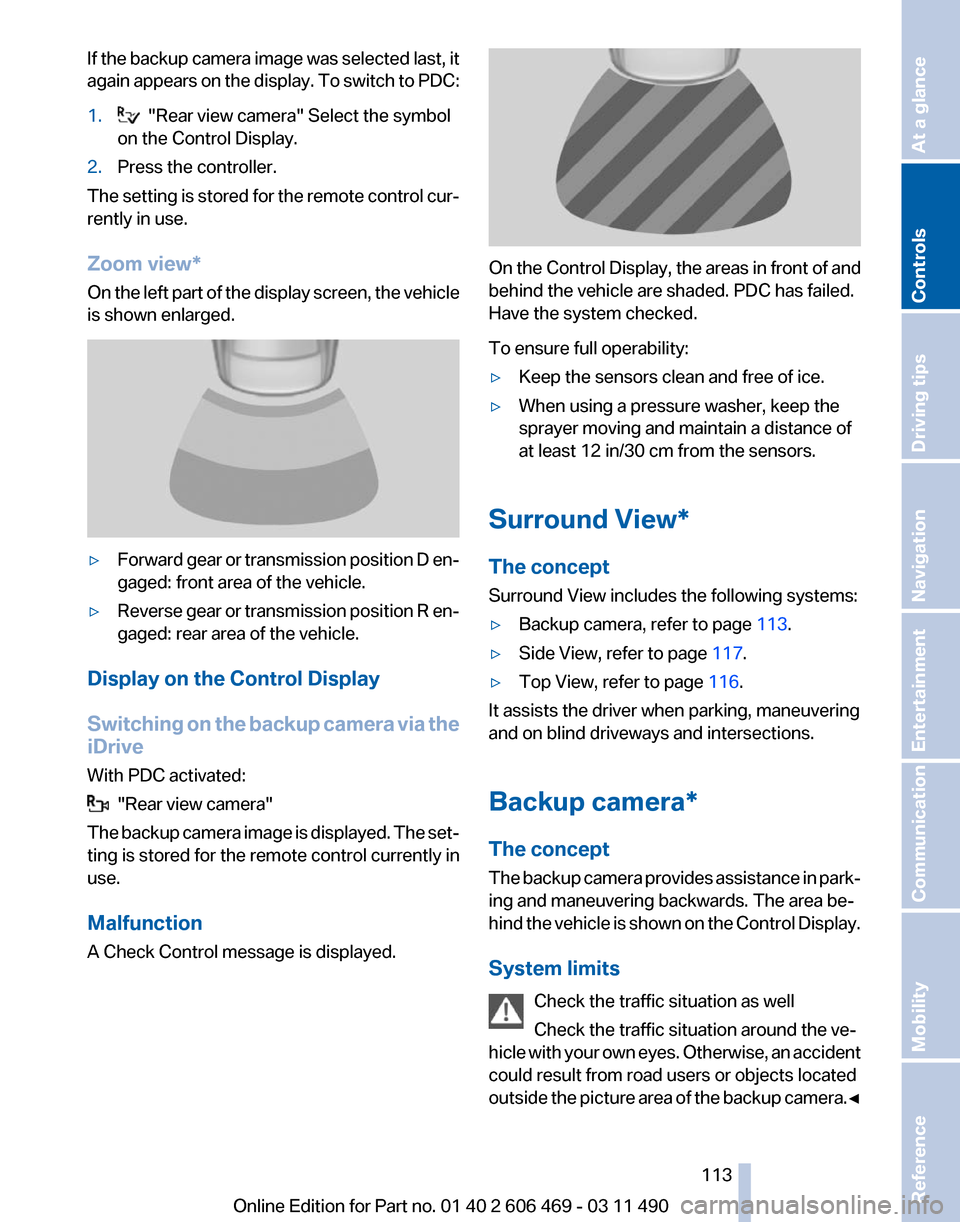
If the backup camera image was selected last, it
again
appears on the display. To switch to PDC:
1. "Rear view camera" Select the symbol
on the Control Display.
2. Press the controller.
The setting is stored for the remote control cur‚Äê
rently in use.
Zoom view*
On
the left part of the display screen, the vehicle
is shown enlarged. ‚ñ∑
Forward gear or transmission position D en‚Äê
gaged: front area of the vehicle.
‚ñ∑ Reverse gear or transmission position R en‚Äê
gaged: rear area of the vehicle.
Display on the Control Display
Switching
on the backup camera via the
iDrive
With PDC activated: "Rear view camera"
The
backup camera image is displayed. The set‚Äê
ting is stored for the remote control currently in
use.
Malfunction
A Check Control message is displayed. On the Control Display, the areas in front of and
behind the vehicle are shaded. PDC has failed.
Have the system checked.
To ensure full operability:
‚ñ∑
Keep the sensors clean and free of ice.
‚ñ∑ When using a pressure washer, keep the
sprayer moving and maintain a distance of
at least 12 in/30 cm from the sensors.
Surround View*
The concept
Surround View includes the following systems:
‚ñ∑ Backup camera, refer to page 113.
‚ñ∑ Side View, refer to page 117.
‚ñ∑ Top View, refer to page 116.
It assists the driver when parking, maneuvering
and on blind driveways and intersections.
Backup camera*
The concept
The
backup camera provides assistance in park‚Äê
ing and maneuvering backwards. The area be‚Äê
hind the vehicle is shown on the Control Display.
System limits
Check the traffic situation as well
Check the traffic situation around the ve‚Äê
hicle with your own eyes. Otherwise, an accident
could result from road users or objects located
outside the picture area of the backup camera.‚óÄ Seite 113
113Online Edition for Part no. 01 40 2 606 469 - 03 11 490
Reference Mobility Communication Entertainment Navigation Driving tips
Controls At a glance
Page 119 of 304
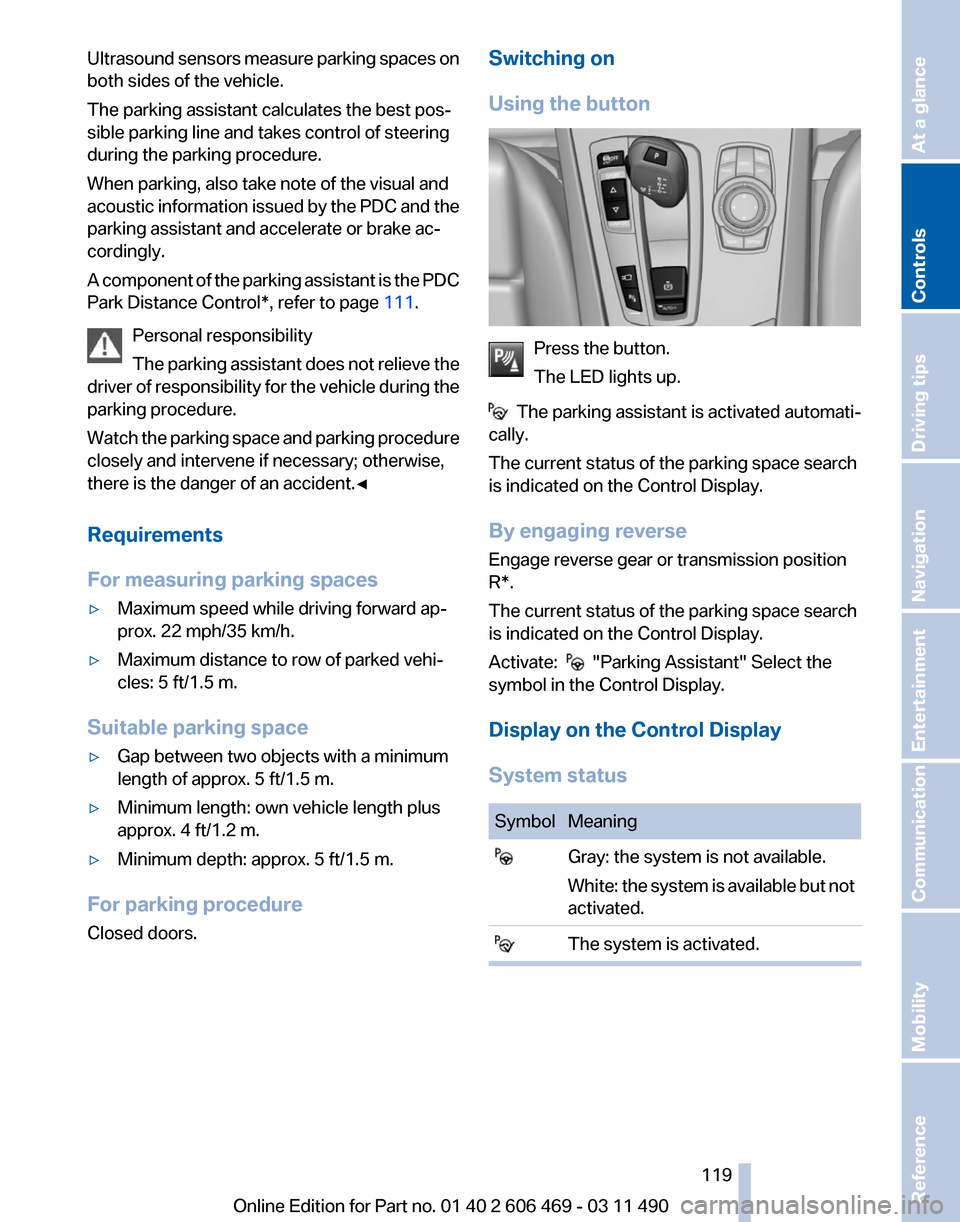
Ultrasound sensors measure parking spaces on
both sides of the vehicle.
The parking assistant calculates the best pos‚Äê
sible parking line and takes control of steering
during the parking procedure.
When parking, also take note of the visual and
acoustic
information issued by the PDC and the
parking assistant and accelerate or brake ac‚Äê
cordingly.
A component of the parking assistant is the PDC
Park Distance Control*, refer to page 111.
Personal responsibility
The parking assistant does not relieve the
driver of responsibility for the vehicle during the
parking procedure.
Watch the parking space and parking procedure
closely and intervene if necessary; otherwise,
there is the danger of an accident.‚óÄ
Requirements
For measuring parking spaces
‚ñ∑ Maximum speed while driving forward ap‚Äê
prox. 22 mph/35 km/h.
‚ñ∑ Maximum distance to row of parked vehi‚Äê
cles: 5 ft/1.5 m.
Suitable parking space
‚ñ∑ Gap between two objects with a minimum
length of approx. 5 ft/1.5 m.
‚ñ∑ Minimum length: own vehicle length plus
approx. 4 ft/1.2 m.
‚ñ∑ Minimum depth: approx. 5 ft/1.5 m.
For parking procedure
Closed doors. Switching on
Using the button
Press the button.
The LED lights up.
The parking assistant is activated automati‚Äê
cally.
The current status of the parking space search
is indicated on the Control Display.
By engaging reverse
Engage reverse gear or transmission position
R*.
The current status of the parking space search
is indicated on the Control Display.
Activate: "Parking Assistant" Select the
symbol in the Control Display.
Display on the Control Display
System status Symbol Meaning
Gray: the system is not available.
White:
the system is available but not
activated. The system is activated. Seite 119
119Online Edition for Part no. 01 40 2 606 469 - 03 11 490
Reference Mobility Communication Entertainment Navigation Driving tips
Controls At a glance
Page 121 of 304
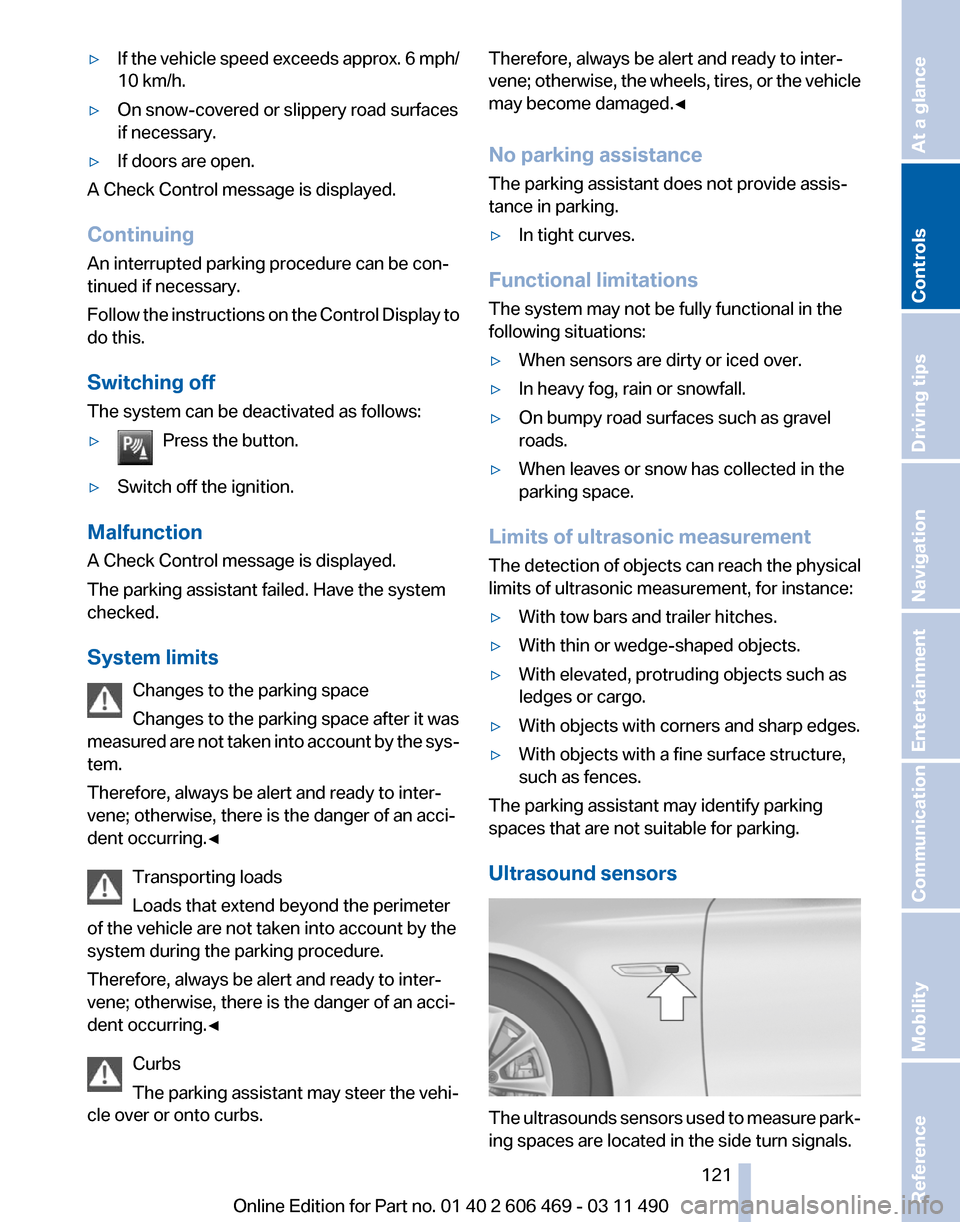
‚ñ∑
If the vehicle speed exceeds approx. 6 mph/
10 km/h.
‚ñ∑ On snow-covered or slippery road surfaces
if necessary.
‚ñ∑ If doors are open.
A Check Control message is displayed.
Continuing
An interrupted parking procedure can be con‚Äê
tinued if necessary.
Follow
the instructions on the Control Display to
do this.
Switching off
The system can be deactivated as follows:
‚ñ∑ Press the button. ‚ñ∑
Switch off the ignition.
Malfunction
A Check Control message is displayed.
The parking assistant failed. Have the system
checked.
System limits Changes to the parking space
Changes to the parking space after it was
measured
are not taken into account by the sys‚Äê
tem.
Therefore, always be alert and ready to inter‚Äê
vene; otherwise, there is the danger of an acci‚Äê
dent occurring.‚óÄ
Transporting loads
Loads that extend beyond the perimeter
of the vehicle are not taken into account by the
system during the parking procedure.
Therefore, always be alert and ready to inter‚Äê
vene; otherwise, there is the danger of an acci‚Äê
dent occurring.‚óÄ
Curbs
The parking assistant may steer the vehi‚Äê
cle over or onto curbs. Therefore, always be alert and ready to inter‚Äê
vene;
otherwise, the wheels, tires, or the vehicle
may become damaged.‚óÄ
No parking assistance
The parking assistant does not provide assis‚Äê
tance in parking.
‚ñ∑ In tight curves.
Functional limitations
The system may not be fully functional in the
following situations:
‚ñ∑ When sensors are dirty or iced over.
‚ñ∑ In heavy fog, rain or snowfall.
‚ñ∑ On bumpy road surfaces such as gravel
roads.
‚ñ∑ When leaves or snow has collected in the
parking space.
Limits of ultrasonic measurement
The
detection of objects can reach the physical
limits of ultrasonic measurement, for instance:
‚ñ∑ With tow bars and trailer hitches.
‚ñ∑ With thin or wedge-shaped objects.
‚ñ∑ With elevated, protruding objects such as
ledges or cargo.
‚ñ∑ With objects with corners and sharp edges.
‚ñ∑ With objects with a fine surface structure,
such as fences.
The parking assistant may identify parking
spaces that are not suitable for parking.
Ultrasound sensors The ultrasounds sensors used to measure park‚Äê
ing spaces are located in the side turn signals.
Seite 121
121Online Edition for Part no. 01 40 2 606 469 - 03 11 490
Reference Mobility Communication Entertainment Navigation Driving tips
Controls At a glance
Page 122 of 304
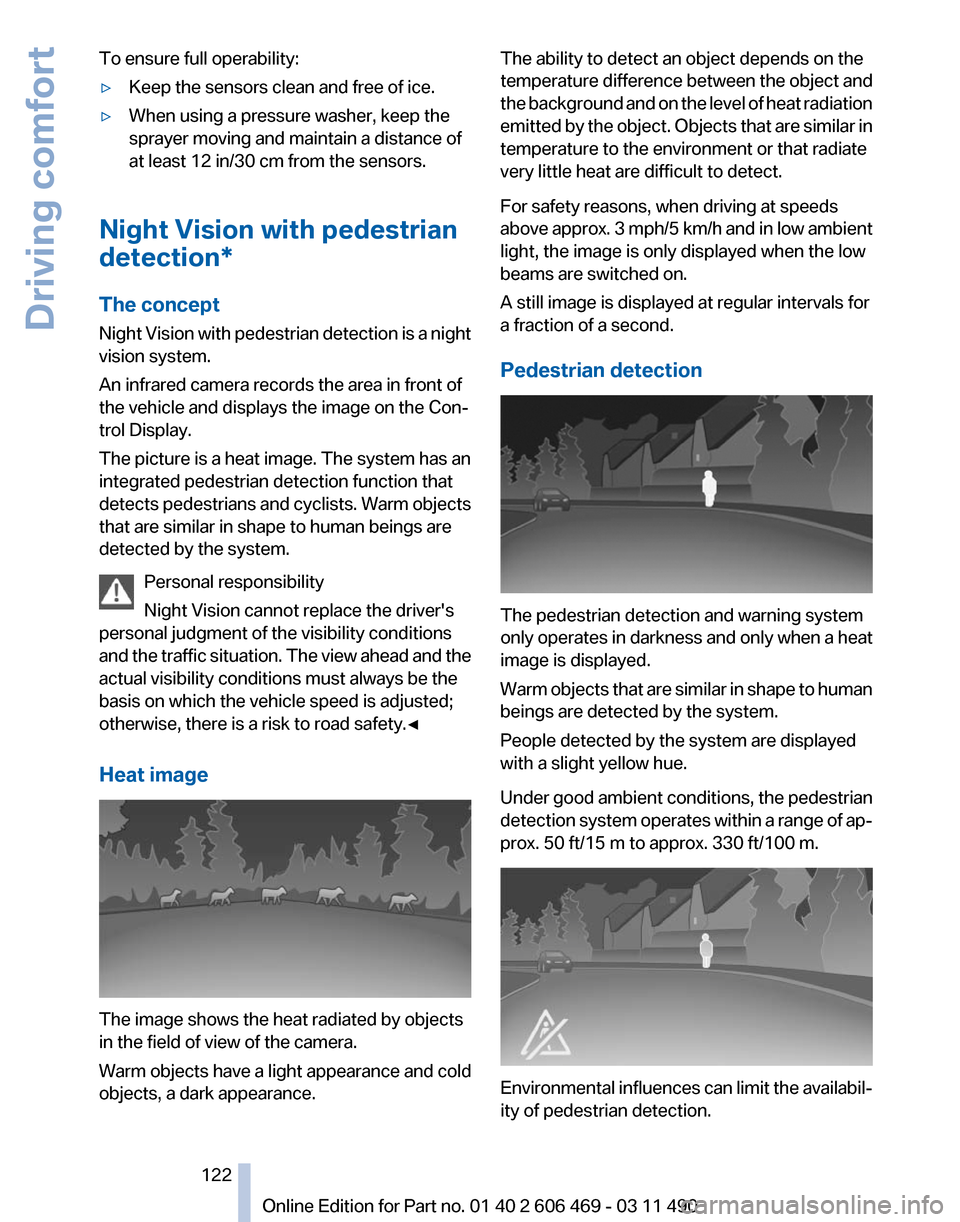
To ensure full operability:
‚ñ∑
Keep the sensors clean and free of ice.
‚ñ∑ When using a pressure washer, keep the
sprayer moving and maintain a distance of
at least 12 in/30 cm from the sensors.
Night Vision with pedestrian
detection*
The concept
Night
Vision with pedestrian detection is a night
vision system.
An infrared camera records the area in front of
the vehicle and displays the image on the Con‚Äê
trol Display.
The picture is a heat image. The system has an
integrated pedestrian detection function that
detects pedestrians and cyclists. Warm objects
that are similar in shape to human beings are
detected by the system.
Personal responsibility
Night Vision cannot replace the driver's
personal judgment of the visibility conditions
and the traffic situation. The view ahead and the
actual visibility conditions must always be the
basis on which the vehicle speed is adjusted;
otherwise, there is a risk to road safety.‚óÄ
Heat image The image shows the heat radiated by objects
in the field of view of the camera.
Warm objects have a light appearance and cold
objects, a dark appearance. The ability to detect an object depends on the
temperature
difference between the object and
the background and on the level of heat radiation
emitted by the object. Objects that are similar in
temperature to the environment or that radiate
very little heat are difficult to detect.
For safety reasons, when driving at speeds
above approx. 3 mph/5 km/h and in low ambient
light, the image is only displayed when the low
beams are switched on.
A still image is displayed at regular intervals for
a fraction of a second.
Pedestrian detection The pedestrian detection and warning system
only
operates in darkness and only when a heat
image is displayed.
Warm objects that are similar in shape to human
beings are detected by the system.
People detected by the system are displayed
with a slight yellow hue.
Under good ambient conditions, the pedestrian
detection system operates within a range of ap‚Äê
prox. 50 ft/15 m to approx. 330 ft/100 m. Environmental influences can limit the availabil‚Äê
ity of pedestrian detection.
Seite 122
122 Online Edition for Part no. 01 40 2 606 469 - 03 11 490
Driving comfort
Page 126 of 304
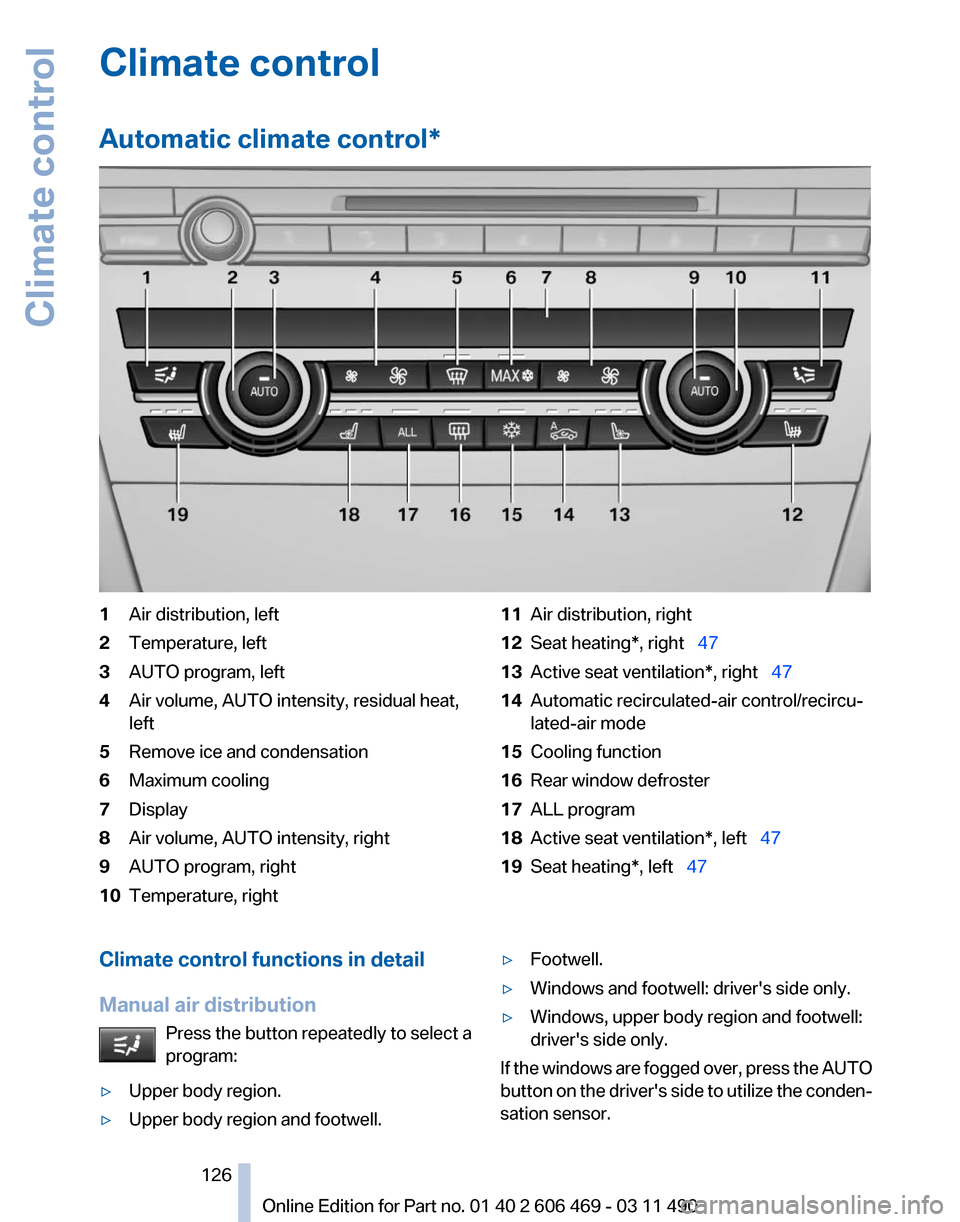
Climate control
Automatic climate control
*1
Air distribution, left
2 Temperature, left
3 AUTO program, left
4 Air volume, AUTO intensity, residual heat,
left
5 Remove ice and condensation
6 Maximum cooling
7 Display
8 Air volume, AUTO intensity, right
9 AUTO program, right
10 Temperature, right 11
Air distribution, right
12 Seat heating*, right‚ÄÇ‚ÄÖ 47
13 Active seat ventilation*, right‚ÄÇ‚ÄÖ47
14 Automatic recirculated-air control/recircu‚Äê
lated-air mode
15 Cooling function
16 Rear window defroster
17 ALL program
18 Active seat ventilation*, left‚ÄÇ‚ÄÖ47
19 Seat heating*, left‚ÄÇ‚ÄÖ 47
Climate control functions in detail
Manual air distribution Press the button repeatedly to select a
program:
‚ñ∑ Upper body region.
‚ñ∑ Upper body region and footwell. ‚ñ∑
Footwell.
‚ñ∑ Windows and footwell: driver's side only.
‚ñ∑ Windows, upper body region and footwell:
driver's side only.
If the windows are fogged over, press the AUTO
button
on the driver's side to utilize the conden‚Äê
sation sensor.
Seite 126
126 Online Edition for Part no. 01 40 2 606 469 - 03 11 490
Climate control
Page 127 of 304
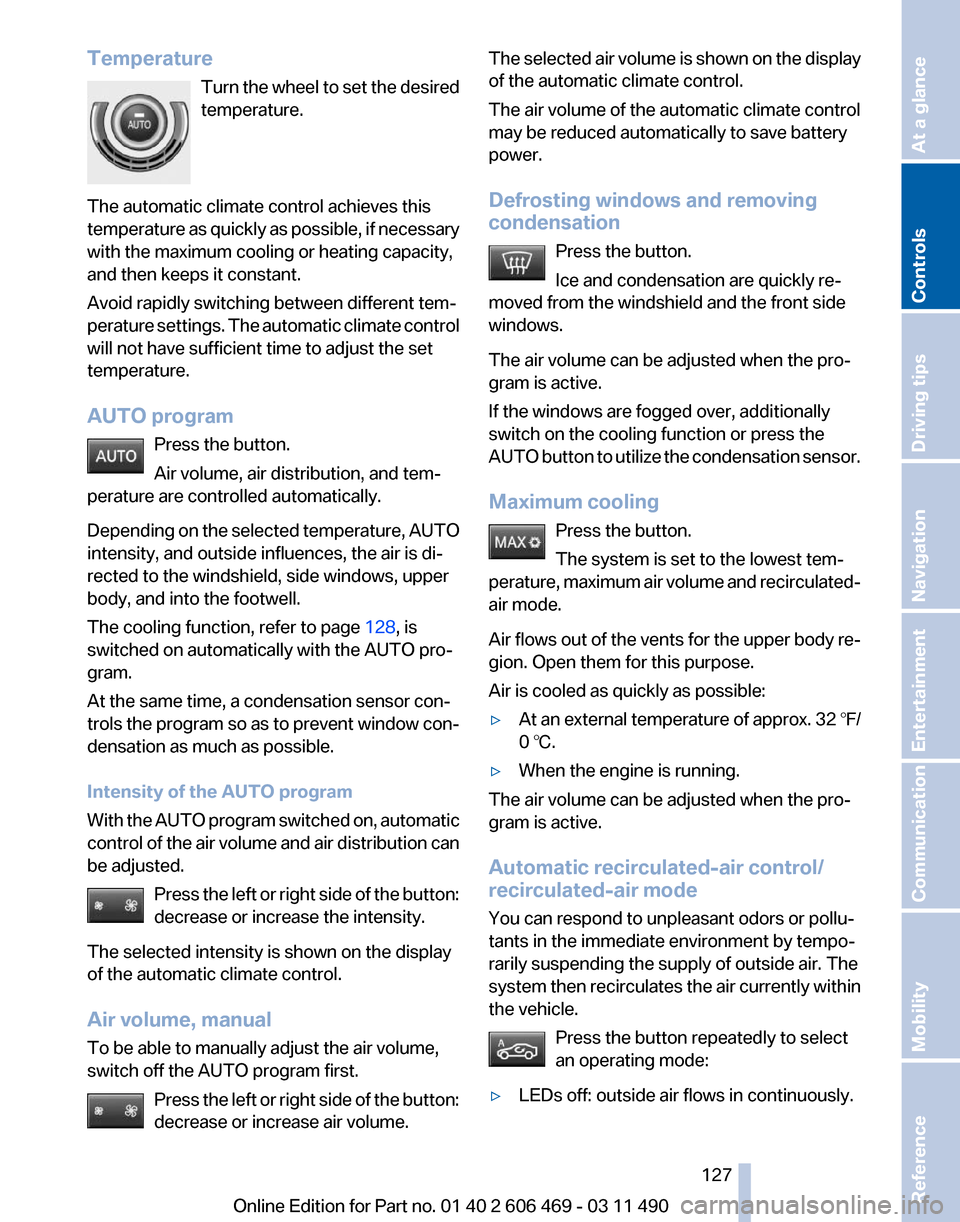
Temperature
Turn the wheel to set the desired
temperature.
The automatic climate control achieves this
temperature as quickly as possible, if necessary
with the maximum cooling or heating capacity,
and then keeps it constant.
Avoid rapidly switching between different tem‚Äê
perature settings. The automatic climate control
will not have sufficient time to adjust the set
temperature.
AUTO program Press the button.
Air volume, air distribution, and tem‚Äê
perature are controlled automatically.
Depending on the selected temperature, AUTO
intensity, and outside influences, the air is di‚Äê
rected to the windshield, side windows, upper
body, and into the footwell.
The cooling function, refer to page 128, is
switched on automatically with the AUTO pro‚Äê
gram.
At the same time, a condensation sensor con‚Äê
trols the program so as to prevent window con‚Äê
densation as much as possible.
Intensity of the AUTO program
With the AUTO program switched on, automatic
control of the air volume and air distribution can
be adjusted.
Press the left or right side of the button:
decrease or increase the intensity.
The selected intensity is shown on the display
of the automatic climate control.
Air volume, manual
To be able to manually adjust the air volume,
switch off the AUTO program first. Press the left or right side of the button:
decrease or increase air volume. The selected air volume is shown on the display
of the automatic climate control.
The air volume of the automatic climate control
may be reduced automatically to save battery
power.
Defrosting windows and removing
condensation
Press the button.
Ice and condensation are quickly re‚Äê
moved from the windshield and the front side
windows.
The air volume can be adjusted when the pro‚Äê
gram is active.
If the windows are fogged over, additionally
switch on the cooling function or press the
AUTO
button to utilize the condensation sensor.
Maximum cooling Press the button.
The system is set to the lowest tem‚Äê
perature, maximum air volume and recirculated-
air mode.
Air flows out of the vents for the upper body re‚Äê
gion. Open them for this purpose.
Air is cooled as quickly as possible:
‚ñ∑ At an external temperature of approx. 32 ‚Ñâ/
0 ‚ÑÉ.
‚ñ∑ When the engine is running.
The air volume can be adjusted when the pro‚Äê
gram is active.
Automatic recirculated-air control/
recirculated-air mode
You can respond to unpleasant odors or pollu‚Äê
tants in the immediate environment by tempo‚Äê
rarily suspending the supply of outside air. The
system
then recirculates the air currently within
the vehicle.
Press the button repeatedly to select
an operating mode:
‚ñ∑ LEDs off: outside air flows in continuously. Seite 127
127Online Edition for Part no. 01 40 2 606 469 - 03 11 490
Reference Mobility Communication Entertainment Navigation Driving tips
Controls At a glance
Page 128 of 304
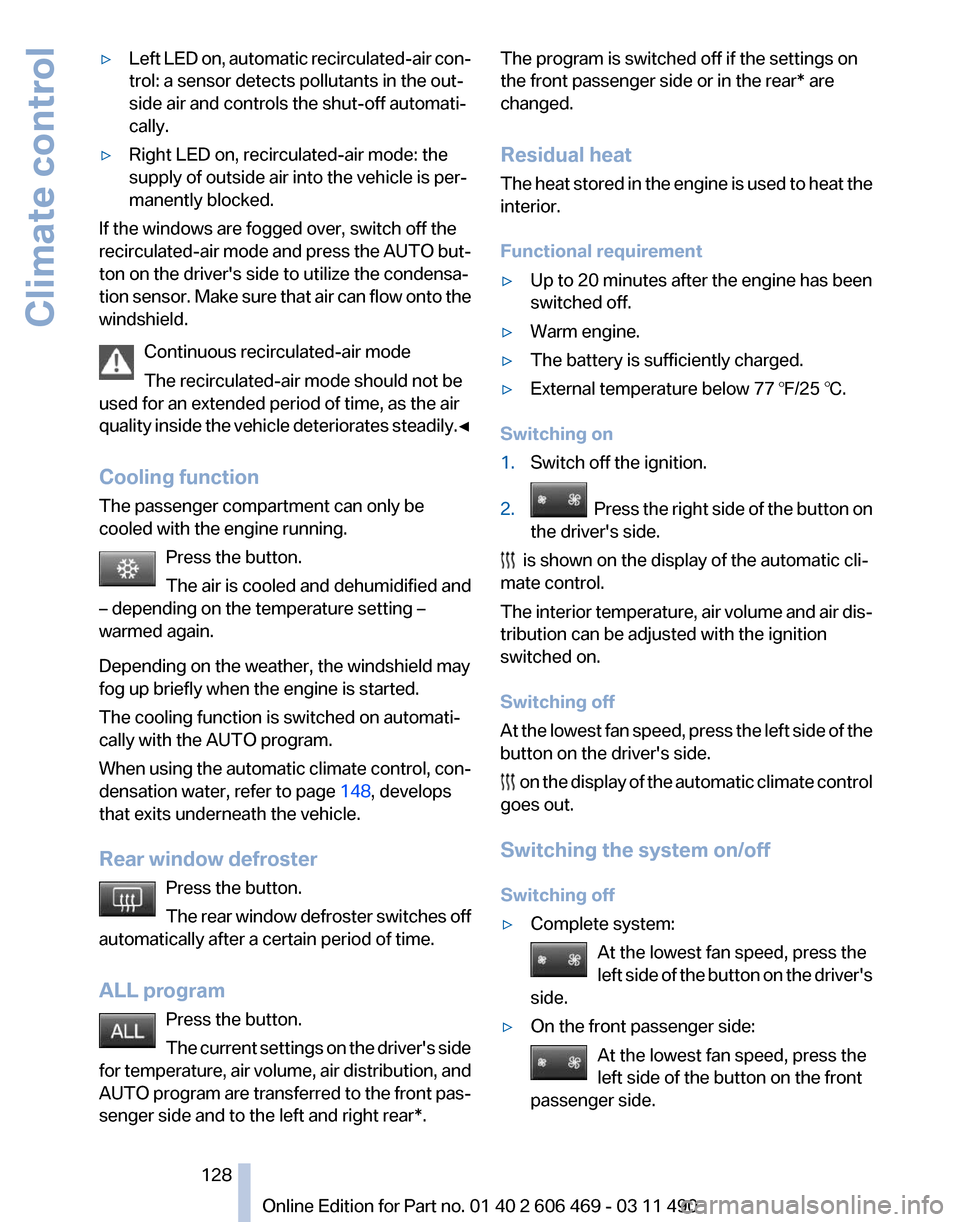
‚ñ∑
Left LED on, automatic recirculated-air con‚Äê
trol: a sensor detects pollutants in the out‚Äê
side air and controls the shut-off automati‚Äê
cally.
‚ñ∑ Right LED on, recirculated-air mode: the
supply of outside air into the vehicle is per‚Äê
manently blocked.
If the windows are fogged over, switch off the
recirculated-air mode and press the AUTO but‚Äê
ton on the driver's side to utilize the condensa‚Äê
tion sensor. Make sure that air can flow onto the
windshield.
Continuous recirculated-air mode
The recirculated-air mode should not be
used for an extended period of time, as the air
quality inside the vehicle deteriorates steadily.‚óÄ
Cooling function
The passenger compartment can only be
cooled with the engine running.
Press the button.
The air is cooled and dehumidified and
– depending on the temperature setting –
warmed again.
Depending on the weather, the windshield may
fog up briefly when the engine is started.
The cooling function is switched on automati‚Äê
cally with the AUTO program.
When using the automatic climate control, con‚Äê
densation water, refer to page 148, develops
that exits underneath the vehicle.
Rear window defroster
Press the button.
The rear window defroster switches off
automatically after a certain period of time.
ALL program
Press the button.
The current settings on the driver's side
for temperature, air volume, air distribution, and
AUTO program are transferred to the front pas‚Äê
senger side and to the left and right rear*. The program is switched off if the settings on
the front passenger side or in the rear* are
changed.
Residual heat
The
heat stored in the engine is used to heat the
interior.
Functional requirement
‚ñ∑ Up to 20 minutes after the engine has been
switched off.
‚ñ∑ Warm engine.
‚ñ∑ The battery is sufficiently charged.
‚ñ∑ External temperature below 77 ‚Ñâ/25 ‚ÑÉ.
Switching on
1. Switch off the ignition.
2. Press the right side of the button on
the driver's side. is shown on the display of the automatic cli‚Äê
mate control.
The
interior temperature, air volume and air dis‚Äê
tribution can be adjusted with the ignition
switched on.
Switching off
At the lowest fan speed, press the left side of the
button on the driver's side. on the display of the automatic climate control
goes out.
Switching the system on/off
Switching off
‚ñ∑ Complete system:
At the lowest fan speed, press the
left
side of the button on the driver's
side. ‚ñ∑
On the front passenger side:
At the lowest fan speed, press the
left side of the button on the front
passenger side. Seite 128
128 Online Edition for Part no. 01 40 2 606 469 - 03 11 490
Climate control